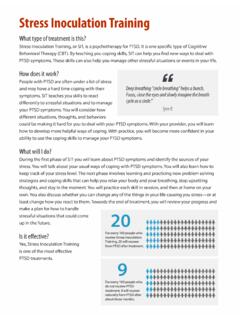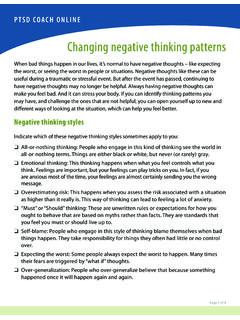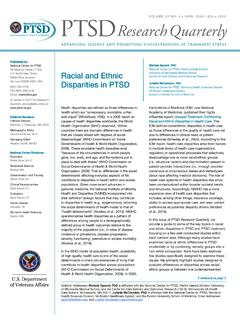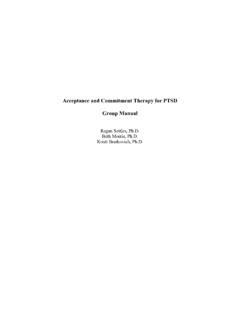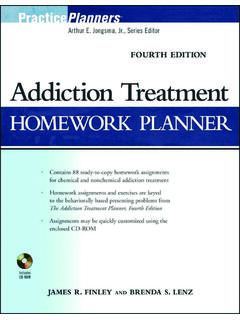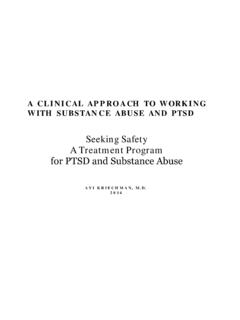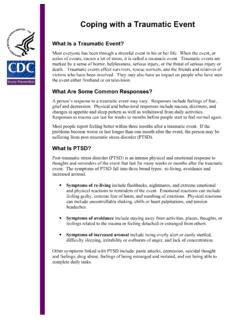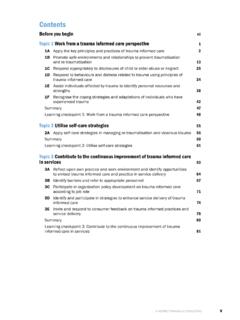Transcription of Post-traumatic stress disorder in the military veteran
1 Post-traumatic stress disorder 0193-953X/94 $ + .20 Post-traumatic stress disorder IN THE military veteran Matthew J. Friedman, MD, PhD, Paula P. Schnurr, PhD, and Annmarie McDonagh-Coyle, MD Before the formalization of Post-traumatic stress disorder ( ptsd ) as a diagnosis in 1980, war-related psychiatric syndromes were known under a variety of names, including shell shock, traumatic war neurosis, and combat exhaustion. Whatever the label, it is clear that these labels referred to a condition much like what we now recognize as ptsd . For example, Kardiner and Spiegel [ 2 0 ] described a chronic traumatic war neurosis that involved preoccupation with the traumatic stressor, nightmares, irritability, increased startle responsiveness, a tendency to angry outbursts, and general impairment of functioning.
2 Futterman and Pumpian-Mindlin [ 17 ] reported a 10% prevalence of traumatic war neurosis in a series of 200 psychiatric patients seen in 1950. They noted as significant the fact that many of the men had not sought treatment even 5 years after the war. Follow-up studies of World War II veterans continued into the 1950s, when veterans of the Korean War were included as a comparison group in some studies. Investigators continued to observe significant symptoms in veterans up to 20 years postcombat. Archibald et al' found World War II combat veterans with "gross stress syndrome" to have severe problems such as increased startle, sleep disturbance, and avoidance of activities reminiscent of combat. A follow-up of these men that included Korean War veterans showed the same symptom profile and relatively more symptoms than in noncombat psychiatric patients or in combat controls.
3 [2] ptsd is a long-term reaction to war-zone exposure. Briefer reactions to combat stress are known by a variety of names, [29] although combat stress reaction (CSR) seems to be the most common. CSRs may be brief, lasting only a few hours or even a few minutes, or may persist for several weeks. Solomon [ 3 9 ] describes six symptom clusters: psychic numbing, anxiety reactions, guilt about functioning, Dr. McDonagh-Coyte is an Ambulatory Case Fellow supported by the Department of Veterans Affairs, White River Junction, Vermont. From the Departments of Psychiatry (MJF, PPS, AMC) and Pharmacology (MJF), Dartmouth Medical School, Hanover, New Hampshire; and the National Center for PostTraumatic stress disorder , White River Junction, Vermont PSYCHIATRIC CLINICS OF NORTH AMERICA VOluUME 17 * NUMBER 2 * JUNE 1994 265266 FRIEDMAN et al depressive reactions, and psychotic-like states.
4 Formal diagnostic criteria, however, do not exist. CSRs may not necessarily share many features with ptsd , but they are strongly predictive of subsequent ptsd . Among Israeli soldiers who fought in the 1982 Lebanon War, ptsd prevalence was dramatically higher among those who had sustained a CSR compared with soldiers who had not. In the CSR group, prevalence estimates were 62% 1 year after the war, 56% 2 years after, and 43% 3 years after; 1-, 2-, and 3-year estimates for the non-CSR group, which was comparable to the CSR group in both demographic background and warzone exposure, were 14%, 17%, and 10%. PREVALENCE Estimates of ptsd prevalence among military veterans vary markedly as a function of the sample and methods used, even in the same war cohort. Few studies of military veterans have used the rigorous sampling methods necessary to derive epidemiologically sound prevalence estimates.
5 Vietnam and Vietnam-Era Veterans The most methodologically adequate study of ptsd in the Vietnam cohort estimated the current prevalence in male Vietnam veterans to be just over 15%. [ 22 ] This study, known as the National Vietnam Veterans Readjustment Study (NVVRS), also estimated the current prevalence of TSD in female Vietnam veterans to be ; current estimates for veterans who served outside of the Vietnam theater were in men and in women. Current ptsd was dramatically higher in men and women with high war-zone exposure: in men and in women. Lifetime ptsd among Vietnam veterans was estimated to be in men and in women. In the NVVRS, current ptsd was higher among blacks ( ) and Hispanics ( ), than among whites ( ). Because individuals exposed to high war zone stress were much more likely to develop ptsd than those exposed to low or moderate stress and because black and Hispanic veterans were much more likely to have had higher war-zone exposure, it was necessary to control for this variable.
6 It also was necessary to control for predisposing factors that might confound ethnicity (such as childhood and family background factors, premilitary factors, and military factors). When this multivariate analysis was performed, the increased prevalence among blacks was explained by their greater amount of combat exposure relative to whites; in contrast, the difference between whites and Hispanics was only partially explained by increased exposure among Hispanics. An important aspect of Kulka et al's [22] study is that they estimated the prevalence of partial ptsd , a subdiagnostic constellation of symptoms that was associated with significant impairment, , having the sufficient number of B (re-experiencing) and D (hyperarousal) symptoms, an insufficient number of C (avoidance/numbing) symptoms, and comorbid alcohol abuse or dependence (which might by interpreted as related to the C symptom cluster) (as per DSMIII-R).
7 Among male theater veterans, lifetime and current prevalence of partial ptsd were and ; comparable estimates for female theater veterans were and Kulka et al note that the combined full and partial lifetimePOST- traumatic stress disorder IN THE military veteran 267 prevalence estimates suggest that more than half of male ( ) and almost half of female ( ) Vietnam veterans have experienced clinically significant symptoms in relation to their war-zone experiences. Other War Cohorts After the formalization of ptsd as a diagnosis, isolated case reports began calling attention to the fact that some veterans of wars before Vietnam had ptsd . Larger studies of older war cohorts began appearing in the mid-1980s, and more recent data show remarkable similarity between World War II and Vietnam veterans in their psychophysiologic reactivity to stimuli reminiscent of their war trauma.
8 [31] The prevalence of ptsd in older veterans, however, is unknown because no study has used a sample representative of the larger population. Estimates from community samples are low-roughly 2% for current ptsd . [28,43] In patients hospitalized for medical illness, Blake et al found the prevalence of current ptsd in World War II and Korean War veterans who had never sought psychiatric treatment to be 9% and 7%. Among those who had previously sought psychiatric treatment, 37% of the World War II veterans and 80% of the Korean War veterans had current ptsd . Rosen et al [32] found that 54% of a group of psychiatric patients who had been in combat during World War II met criteria for ptsd . The prevalence of current ptsd was 27%. Data show evidence of ptsd in American men and women who served in the Persian Gulf (Wolfe J: unpublished data, 1993).
9 A few days after return to the United States, the prevalence of current ptsd in men was and in women Approximately 18 months later, these figures increased to and This study is important herause it demonstrates that ptsd may occur in military personnel who had relatively brief war-zone exposure, even following a successful war that received much popular support. PSYCHIATRIC AND PSYCHOSOCIAL CORRELATES ptsd in the military veteran is frequently associated with other psychiatric disorders , especially major depressive disorder and alcohol and substance use disorders . Kulka et al [ 22 ] reported that male Vietnam veterans with ptsd were more likely than theater veterans without ptsd to have a history of lifetime dysthymia and of lifetime and current major depressive episode, panic disorder , obsessive disorder , generalized anxiety disorder , alcohol abuse/dependence, substance abuse/dependence, and antisocial personality disorder .
10 Female veterans with ptsd were similar to their male counterparts except that they did not differ from female veterans without ptsd in the prevalence of current obsessivecompulsive disorder , current alcohol abuse/dependence, and lifetime substance abuse/dependence; figures for current substance abuse and both lifetime and current antisocial personality disorder were not analyzed because of sample size limitations. [ 22 ] The temporal relationship between ptsd and other comorbid disorders may differ as a function of war cohort. Davidson et al [9] reported that age of onset for ptsd was similar in both World War II and Vietnam veterans, but relatively more Vietnam veterans had a psychiatric diagnosis that predated their experiences in combat. military veterans with ptsd also may experience functional impairment, especially, we suspect, if the course of their disorder is chronic.



